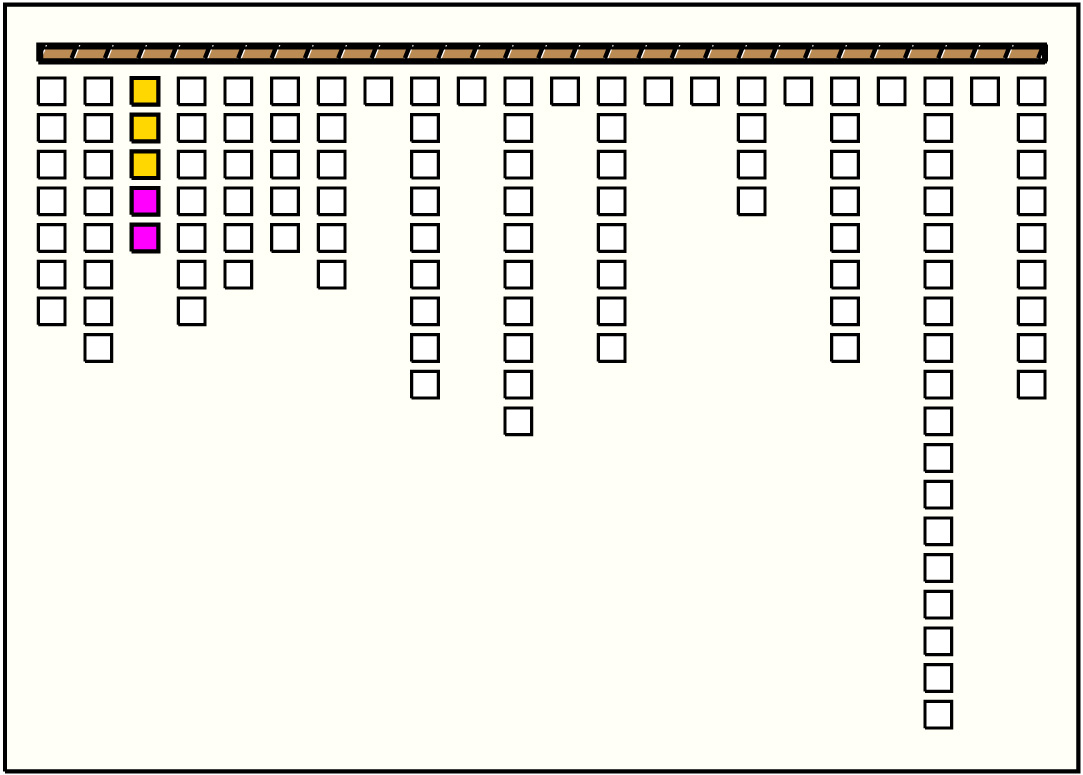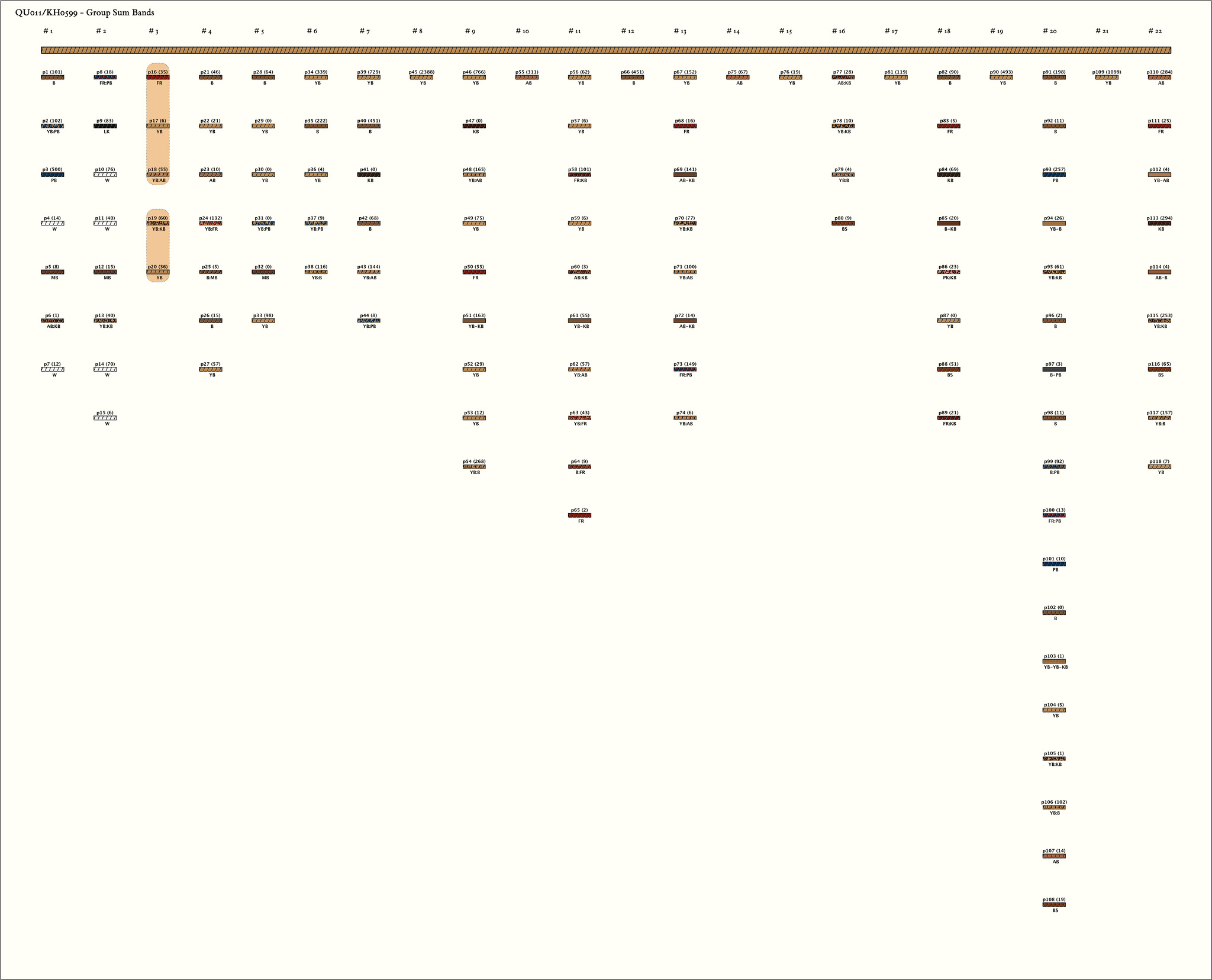QU011/KH0599 - Group Sum Bandss
Drawings:
Group Sum Bands:
Click on Image to View Larger
Individual Group Sum Bands: - Click on column name to sort
| # | Group Sum Bands Schema | Group Position 1 Based Index |
Split Index 1 Based Index |
Left Sum 1 Based Index |
Right Sum 1 Based Index |
|---|---|---|---|---|---|
| 0 |  | 002 | 4 | 96 = FR@[3, 1]:35 + PB@[3, 1, 1]:45 + *?*p16s1s1*?* | 96 = YB@[3, 2]:6 + YB@[3, 2, 1]:19 + KB@[3, 2, 2]:6 + YB:AB@[3, 3]:55 + YB:KB@[3, 4]:60 + YB@[3, 5]:36 + YB@[3, 5, 1]:9 |
Khipu Notes:
Whole khipu with subsidiary main cord
Includes 3 scrap packages
A = 1 fragment; B = 1 fragment; C = 8 fragments
All strings Z-spun/S-plied. All knots in Z-direction until String 38, then all are S except figure-8s.
Non-cotton fiber identifications were not confirmed with microscope or burn test
After 24cm, main cord makes a single knot around another cord, which uses its long knot and they interlock. 13cm of the main cord comes out of this knot and has an end knot. The 2nd cord (maybe a top cord) is mot dk tn/lt tn with (going from the plied end) one S-single, one S3L (which uses its outer cord to interlock with main cord), 6 S-singles, and then another S-long knot with 8 turns. Interlocked thru the 1st single of the "top cord" there is a "subsidiary top"
There seem to be at least 8 colors employed (lt/md/dk/ru -br, lt/dk tn, bl, and wh), but there are nuances that cannot be accounted for here and the blues (indigo) vary but very little and probably were originally the same hue.
Main cord is 2 light brown strings S -twisted. 42.5in/108cm long to its end "knot."
Decimal hierarchy and registers of knots are not followed, therefore knots listed by 1st, 2nd, 3rd on a single string and cord value totals not calculated (when a group seems to follow a register, those knots are kept in the same column as others in their register).
"Values" are only suggested.
This piece breaks from a lot of expected patterns: registers, decimals, color changes, using a stripe within a striped cord, the anomaly of the main cord/top cord, etc.
Some loose cords from package B380 were found to be associated with this khipu and have been added to the data above (Groups 1 and 2).
Material identifications are difficult at this time -- need to use a microscope to test samples.
Big, uneven group spaces -- this is not an easily read, binary khipu.
The indigo dye is greenish-blue in some places, like those found at Laguna de los Condores.
How are the groups related? They are not consistent with each other.
Camelid fiber is only used in the "introductory groups" (the groups that all follow same decimal system and have similar characteristics - their subsidiaries also follow a loose pattern).
What is the purpose of the pendants found by themselves? They seem to match with a nearby group, but how do they relate?
Beginning with Pendant 38, all knots turn from Z direction to S, except for the figure-8s (Es).
Recto attachments of pendants also switch to verso with Pendant 76 (which is one of the solo pendants not directly linked with grp).
No subsidiaries in Groups 13, 18, or 20.
Some tertiary cords appear.
Maybe in some places there are 2 knot types ( or 2 long knots) in one register because the information changed and something needed to be added?
Medium brown color is a chocolatey-brown.
There are actually 15 Groups if we do not count each of the individual cords as their own grouping. 118 pendants.
Subsidiary cord 115A is much shorter than others. Did they run out of indigo-dyed cotton?
2 places with inverted long knots ("Tupicocha knot" in Salomon 2004).
Includes 3 scrap packages
A = 1 fragment; B = 1 fragment; C = 8 fragments
All strings Z-spun/S-plied. All knots in Z-direction until String 38, then all are S except figure-8s.
Non-cotton fiber identifications were not confirmed with microscope or burn test
After 24cm, main cord makes a single knot around another cord, which uses its long knot and they interlock. 13cm of the main cord comes out of this knot and has an end knot. The 2nd cord (maybe a top cord) is mot dk tn/lt tn with (going from the plied end) one S-single, one S3L (which uses its outer cord to interlock with main cord), 6 S-singles, and then another S-long knot with 8 turns. Interlocked thru the 1st single of the "top cord" there is a "subsidiary top"
There seem to be at least 8 colors employed (lt/md/dk/ru -br, lt/dk tn, bl, and wh), but there are nuances that cannot be accounted for here and the blues (indigo) vary but very little and probably were originally the same hue.
Main cord is 2 light brown strings S -twisted. 42.5in/108cm long to its end "knot."
Decimal hierarchy and registers of knots are not followed, therefore knots listed by 1st, 2nd, 3rd on a single string and cord value totals not calculated (when a group seems to follow a register, those knots are kept in the same column as others in their register).
"Values" are only suggested.
This piece breaks from a lot of expected patterns: registers, decimals, color changes, using a stripe within a striped cord, the anomaly of the main cord/top cord, etc.
Some loose cords from package B380 were found to be associated with this khipu and have been added to the data above (Groups 1 and 2).
Material identifications are difficult at this time -- need to use a microscope to test samples.
Big, uneven group spaces -- this is not an easily read, binary khipu.
The indigo dye is greenish-blue in some places, like those found at Laguna de los Condores.
How are the groups related? They are not consistent with each other.
Camelid fiber is only used in the "introductory groups" (the groups that all follow same decimal system and have similar characteristics - their subsidiaries also follow a loose pattern).
What is the purpose of the pendants found by themselves? They seem to match with a nearby group, but how do they relate?
Beginning with Pendant 38, all knots turn from Z direction to S, except for the figure-8s (Es).
Recto attachments of pendants also switch to verso with Pendant 76 (which is one of the solo pendants not directly linked with grp).
No subsidiaries in Groups 13, 18, or 20.
Some tertiary cords appear.
Maybe in some places there are 2 knot types ( or 2 long knots) in one register because the information changed and something needed to be added?
Medium brown color is a chocolatey-brown.
There are actually 15 Groups if we do not count each of the individual cords as their own grouping. 118 pendants.
Subsidiary cord 115A is much shorter than others. Did they run out of indigo-dyed cotton?
2 places with inverted long knots ("Tupicocha knot" in Salomon 2004).
